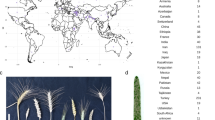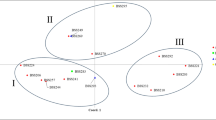Abstract
Landraces of maize represent a valuable genetic resource for breeding and genetic studies. Using simple sequence repeat (SSR) markers, we analysed five flint maize populations from Central Europe that had played an important role in the pre-hybrid era in Germany. Our objectives were to (1) investigate the molecular genetic diversity within and among the populations based on the SSR analysis of individuals, (2) compare these results of the SSR analysis based on individuals with those based on bulks, (3) examine genotype frequencies for deviations from Hardy–Weinberg equilibrium (HWE) at individual loci, and (4) test for linkage disequilibrium (LD) between pairs of loci within populations. Thirty individuals and their bulked DNA per population were fingerprinted with 55 SSR markers. Across all populations, 46.7% of the SSR markers deviated significantly from HWE, with an excess of homozygosity in 97% of the cases. This excess of homozygosity can largely be explained by experimental errors during the amplification of SSRs apart from genuine genetic causes. Allele frequencies of the SSR analyses of individuals and bulks were significantly correlated (r=0.85, P< 0.01), suggesting that SSR analysis of bulks is very cost-effective for large-scale molecular characterisation of germplasm collections. No evidence for genome-wide LD among pairs of loci was observed, indicating that the populations are well suited for high resolution association mapping studies.




Similar content being viewed by others
References
Dubreuil P, Charcosset A (1998) Genetic diversity within and among maize populations: a comparison between isozyme and RFLP loci. Theor Appl Genet 96:577–587
Dubreuil P, Rebourg C, Merlino M, Charcosset A (1999) Evaluation of a DNA pooled-sampling strategy for estimating the RFLP diversity of maize populations. Plant Mol Biol Rep 17:123–138
Falconer DS, TFC Mackay (1996) Introduction to quantitative genetics, 4th edn. Longman Group Ltd, London
Gauthier P, Gouesnard B, Dallard L, Redaelli R, Rebourg C, Charcosset A, Boyat A (2002) RFLP diversity and relationships among traditional European maize populations. Theor Appl Genet 105:91–99
Goodman MM, Stuber CW (1983) Races of maize: VI. Isozyme variation among races of maize in Bolivia. Maydica 28:169–187
Gower JC (1966) Some distance properties of latent root and vector methods used in multivariate analysis. Biometrika 53:325–338
Guo S, Thompson E (1992) Performing the exact test of Hardy-Weinberg proportion for multiple alleles. Biometrics 48:361–372
Hardy GH (1908) Mendelian proportions in a mixed population. Science 28:49–50
Hollander M, Wolfe DA (1973) Nonparametric statistical inference. Wiley, New York, pp 139–146
Ihaka R, Gentleman R (1996) A language for data analysis and graphics. J Comput Graph Stat 53:299–314
Kahler AL, Hallauer AR, Gardner CO (1986) Allozyme polymorphisms within and among open-pollinated and adapted exotic populations of maize. Theor Appl Genet 72:592–601
Kimura M, Ohta T (1978) Stepwise mutation model and distribution of allelic frequencies in a finite population. Proc Natl Acad Sci USA 75:2868–2872
Labate JA, Lamkey KR, Lee M, Woodman W (2000) Hardy-Weinberg and linkage equilibrium estimates in the BSSS and BSCB1 random mated populations. Maydica 45:243–255
Labate JA, Lamkey KR, Mitchell SH, Kresovich S, Sullivan H, Smith JSC (2003) Molecular and historical aspects of Corn Belt dent diversity. Crop Sci 43:80–91
Legendre P, Legendre L (1998) Numerical ecology, 2nd edn. Elsevier, Amsterdam
Lewis PO, Zaykin D (1999) Genetic data analysis. Computer program for the analysis of allelic data. Version 1.0. Distributed by the authors at (http://lewis.eeb.uconn.edu/lewishome/software.html). (verified 1 August 2004). Lewis Labs, Univ. of Connecticut, Storrs, CT
Liu K, Goodman M, Muse S, Smith JS, Buckler E, Doebley J (2003) Genetic structure and diversity among maize inbred lines as inferred from DNA microsatellites. Genetics 165:2117–2128
Lynch M, Walsh B (1997) Genetics and analysis of quantitative traits. Sinauer Assoc, Sunderland, p 413
Matsuoka Y, Mitchell SE, Kresovich S, Goodman M, Doebley J (2002) Microsatellites in Zea—variability, patterns of mutations, and use for evolutionary studies. Theor Appl Genet 104:436–450
Maurer HP, Melchinger AE, Frisch M (2004) Plabsoft: software for simulation and data analysis in plant breeding. XVIIth EUCARPIA General Congress 2004, Tulln, Austria
Nei M (1987) Molecular evolutionary genetics. Columbia University Press, New York
Oettler G, Schnell FW, Utz HF (1976) Die westdeutschen Getreide- und Kartoffelsortimente im Spiegel ihrer Vermehrungsflächen. In: Alleweldt G (ed) Hohenheimer Arbeiten Schriftenreihe der Universität Hohenheim Reihe:Pflanzliche Produktion. Verlag Eugen Ulmer, Stuttgart, Germany
Patefield WM (1981) Algorithm AS159. An efficient method of generating r×c tables with given row and column totals. Appl Stat 30:91–97
Powell W, Morgante M, Andre C, Hanafey M, Vogel J, Tingey S, Rafalski A (1996) The comparison of RFLP, RAPD, AFLP, and SSR (microsatellite) markers for germplasm analysis. Mol Breed 2:225–238
Pritchard JK, Stephens M, Donnelly P (2000) Inference of population structure using multilocus genotype data. Genetics 155:945–959
Rebourg C, Gouesnard B, Charcosset A (2001) Large scale molecular analysis of traditional European maize populations. Relationships with morphological variation. Heredity 86:574–587
Rebourg C, Gouesnard B, Welcker C, Dubreuil P, Chastanet M, Charcosset A (2003) Maize introduction into Europe: the history reviewed in the light of molecular data. Theor Appl Genet 106:895–903
Reif JC, Xia XC, Melchinger AE, Warburton ML, Hoisington DA, Beck D, Bohn M, Frisch M (2004) Genetic diversity determined within and among CIMMYT maize populations of tropical, subtropical, and temperate germplasm by SSR markers. Crop Sci 44:326–334
Reif JC, Hamrit S, Heckenberger M, Schipprack W, Bohn M, Melchinger AE (2005) Trends in genetic diversity among European maize cultivars and their parental components during the past 50 years. Theor Appl Genet (in press)
Remington DL, Thornsberry JM, Matsuoka Y, Wilson LM, Whitt SR, Doebley J, Kresovich S, Goodman MM, Buckler E (2001) Structure of linkage disequilibrium and phenotypic associations in the maize genome. Proc Natl Acad Sci USA 98:11479–11484
Revilla P, Vales MI, Malvar RA, Ordas A (1997) Allozyme frequencies, heterozygosity and genetic distances following S1 recurrent selection in two synthetic maize populations. Theor Appl Genet 95:1057–1061
Saghai-Maroof MA, Soliman KM, Jorgenson R, Allward RW (1984) Ribosomal DNA spacer length polymorphisms in barley: Mendelian inheritance, chromosomal location and population dynamics. Proc Natl Acad Sci USA 81:8014–8018
Schnell FW (1992) Maiszüchtung und die Züchtungsforschung in der Bundesrepublik Deutschland. Vorträge Pflanzenzüchtung 22:27–44
Senior ML, Murphy JP, Goodman MM, Stuber CW (1998) Utility of SSRs for determining genetic similarities and relationships in maize using an agarose gel system. Crop Sci 38:1088–1098
Smith JSC, Chin ECL, Shu H, Smith OS, Wall SJ, Senior ML, Mitchell SE, Kresovich S, Ziegle J (1997) An evaluation of utility of SSR loci as molecular markers in maize (Zea mays L.): comparisons with data from RFLPs and pedigree. Theor Appl Gen 95:163–173
Snedecor GW, Cochran WG (1980) Statistical methods. Iowa State University Press, Ames
Vigouroux Y, Jaqueth JS, Matsuoka Y, Smith OS, Beavis WD (2002) Rate and pattern of mutation at microsatellite loci in maize. Mol Biol Evol 19:1251–1260
Warburton ML, Xianchun X, Crossa J, Franco J, Melchinger AE, Frisch M, Bohn M, Hoisington D (2002) Genetic characterization of CIMMYT inbred maize lines and open pollinated populations using large scale fingerprinting methods. Crop Sci 42:1832–1840
Weinberg W (1909) Über Vererbungsgesetze beim Menschen. Zeitschrift für induktive Abstammungs- und Vererbungslehre 1:377–393
Weir BS (1996) Genetic data analysis II, 2nd edn. Sinauer Associates Inc, Sunderland
Wright S (1978) Evolution and genetics of populations, Vol. IV. The Univ of Chicago Press, Chicago, IL, p 91
Acknowledgments
This research was part of project ‘Genetic Diversity in Agriculture: Temporal Flux, Sustainable Productivity and Food Security’, which was supported by a research grant from the European Union in Framework 5 Quality of life and management of living resources program (QLRT-2000-00934). We gratefully acknowledge the technical assistance of Ms. E. Kokai-Kota in generating part of the SSR data. The authors thank two anonymous reviewers for their valuable suggestions.
Author information
Authors and Affiliations
Corresponding author
Additional information
Communicated by D. A. Hoisington
Rights and permissions
About this article
Cite this article
Reif, J.C., Hamrit, S., Heckenberger, M. et al. Genetic structure and diversity of European flint maize populations determined with SSR analyses of individuals and bulks. Theor Appl Genet 111, 906–913 (2005). https://doi.org/10.1007/s00122-005-0016-1
Received:
Accepted:
Published:
Issue Date:
DOI: https://doi.org/10.1007/s00122-005-0016-1




